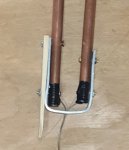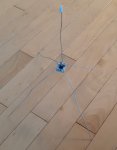Tell you if you did anything wrong......
Well, lets see now. First, the choice of antenna in my opinion is wrong, you would probably be better off making a 1/4 wave ground plane. No, you would defiantly be better off with a 1/4 wave ground plane as you would not have made so many mistakes. Next, what is that speaker wire doing connected to the antenna? Speaker wire is not balanced antenna line and is super lossy at HF and this is a UHF application. How did you determine the connection point for the feedline, or non feedline in this case? Its usually up higher, maybe half way or so on the shorter pipe and determined with an antenna analyzer or transmitting and adjusting for lowest SWR. You can't just pick a spot to connect the feedline. What you have is simply a shorted feedline by connecting both at the bottom of each vertical pipe. The copper J pole instructions call for having copper pipe bends and a short copper pipe joining the two vertical sections, why is there a bent aluminum thing holding it all together?
I think I'll stop here and hope you explore the 1/4 wave ground plane. A J pole has way too many variables and unless you have an antenna analyzer or transmitter and SWR meter it will never work right, even if you built it exactly like the instructions you followed. Even if you build it perfect and tune it perfect, its maybe slightly better than a 1/4 ground plane with about 5X as much work and cost.
Sorry to be so hard on you but if your going to do a project, build it exactly like the instructions and don't change out parts or do anything different. Otherwise you will not have anything close to what the project is supposed to be. Other types of antennas at lower frequencies can be diddled a bit without ending up with a useless lump of metal in the end but seldom with a UHF or higher frequency antenna.







